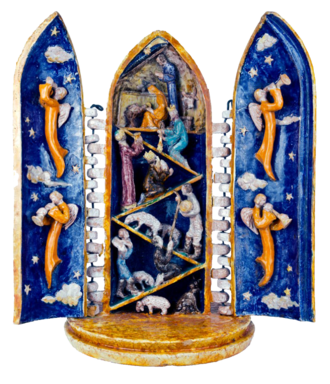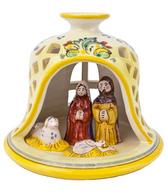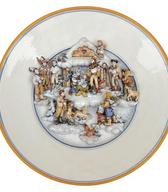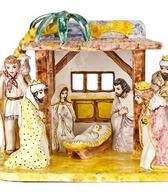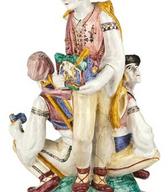Betlehemy - Ceramic creches from Slovakia
Itinerant exhibition
Slovene Ethnographic Museum, 7 December 2012 – 13 January 2013
Betlehemy
Ceramic Cribs form Slovakia
Guest Exhibition, Slovakia
Since the middle ages, Slovak potters have been making ceramic cribs out of fired clay and they kept their tradition till today. The exhibition presents 24 colourful cribs made by well known folk artists and in each is Christmas story presented in some other way.
Ceramic crèches from Slovakia presented at the exhibition are made by well known folk artists like Viliam Bazlik, Ignác Bizmayer, Drahoslav Chalány, Jozef Franko, Maria and Oskar Hanusek, Ferdiš Kostka, Júlia Kováčiková-Horová, Dagmar Kratochvílová, Marián Liška, Peter Lužák, Ján Pečuk, Kornélia Püssová, Jana Randušková, and Leopold Velan are both colourful and expressive. In some crèches the figures stand sepa-rately; in others they are connected to a frame. Some ceramic artists show the Christmas story playing under a straw roof; others make a stage out of the base of a wide- rimmed plate. There is also an unusual triptych showing the Christmas story in an altarpiece.
According to the biblical creation story man was formed “from the dust of the ground” (Genesis 2:7 NRSV). Adam and Eve, the first man and woman are remembered by the church on December 24th. This is the day before Christmas on which the birth of Christ is remembered. According to Christian belief, Jesus Christ, the son of God, was born of the Virgin Mary one night in the stable of an inn in Betlehem.
The fascination of seeing the events of the holy night come alive again every year is behind the custom of creating crèches and setting them up at Christmas time. Crèches are made of different materials, e.g. of ceramic. And Adam and Eve are the patrons of potters and ceramists.
Christianity has a long tradition in Slovakia. It shaped the life of the people and their material culture, particularly showing in religious folk art. Among sculptural portrayals of the events of the Christian year, crèche scenes have a special place. The reforms of Emperor Joseph II at the end of the 18th century banished the crèche scenes from the churches, and people began to set crèches up in their homes.
Since the middle ages, potters have been making figures out of fired clay well as crockery and tiles. Since the 17th century some of these small figures have been made using faience techniques. They filled up empty spaces in the kilns of the Haban community. During the 19th century they were developed into a distinct ceramic craft. Modra's majolica factory was set up in 1883, at a time when industrial products and new materials were creating difficulties for the traditional potters. The school attached to the factory trained many Slovak ceramic artists in making faience.
The most important figures in a traditional Slovak crèche are the holy family, the three kings, shepherds, sometimes also the kolednici (Slovak carollers): The three shepherds, Fedor, Stacho and Kubo, in traditional Slovak dress including the shepherd's axe valaška, go from house to house carrying a wooden or paper crèche. They tell the story of Christ's birth, dancing and singing to the rhythm of beating sticks, in return for special cakes.
As in other European countries, the crèche was the centre of Christmas celebrations until it was displaced by the Christmas tree during the 19th century. Modern ceramic artists continue to devote time to Christmas themes and figures even today.
EXHIBITION CURATORS:
Claudia Peschel-Wacha, Katharina Richter-Kovarik, Österreichisches Museum für Volkskunde.
THE OBJECTS FOR THE EXHIBITION WERE LOANED BY:
Múzeum l'udovej umeleckej vỳroby, ÚL'UV, Stupava
Malokarpatské Múzeum, Pezinok
Slovenské Národné Múzeum - Múzeum L'udovíta Štúra, Modra
Slovenské Národné Múzeum - Historcké Múzeum, Bratislava
Izposoja od zasebnikov / Private loans: Peter Lužák, Marián Liška, Oskar Hanusek, Mária Hanusková

